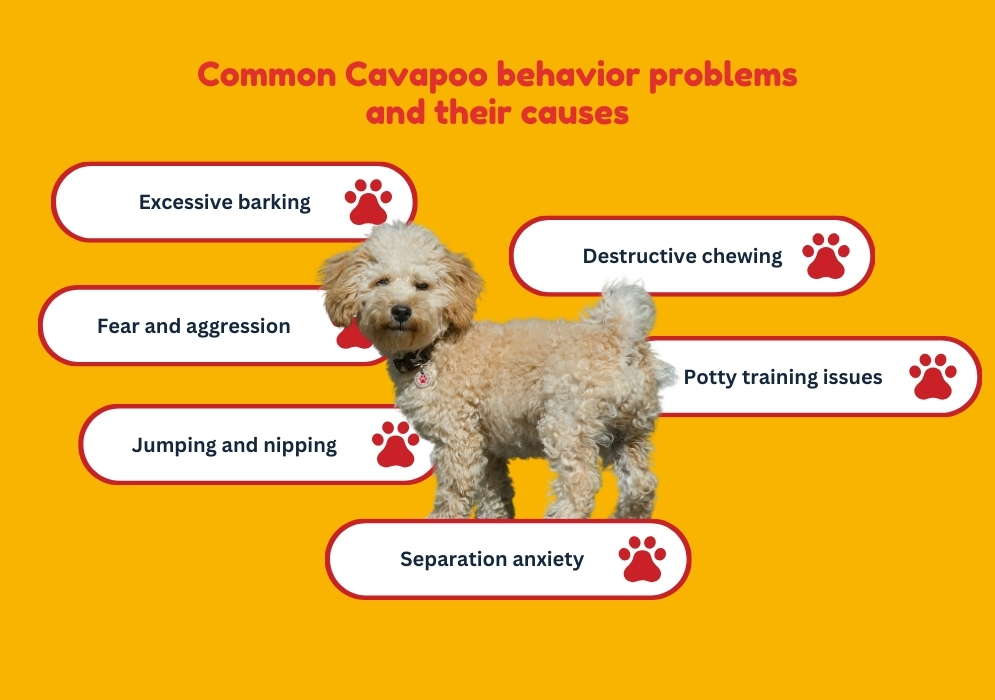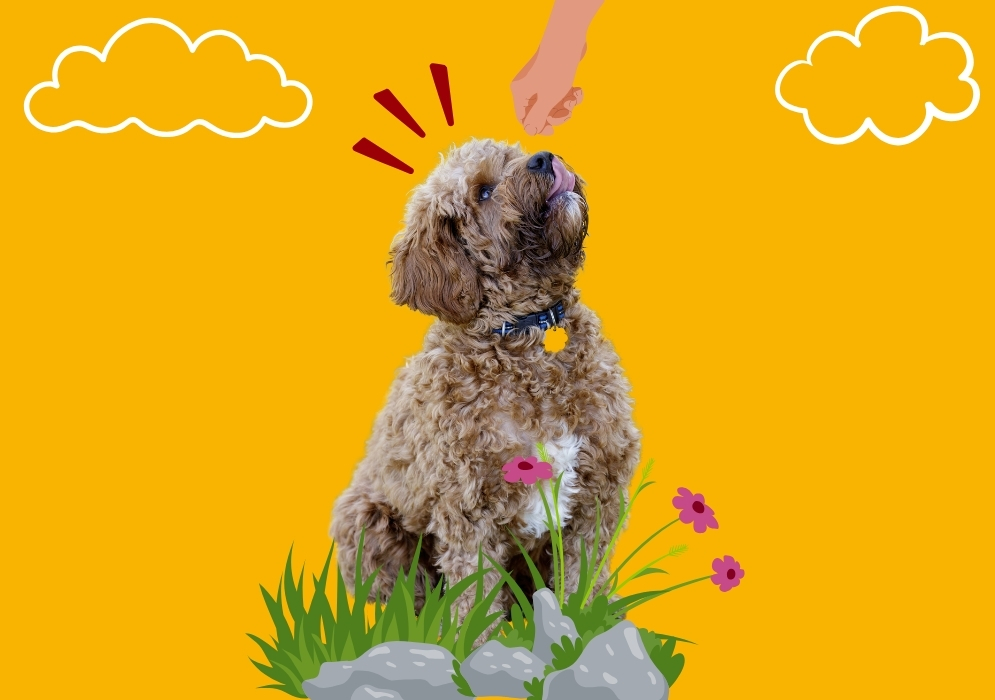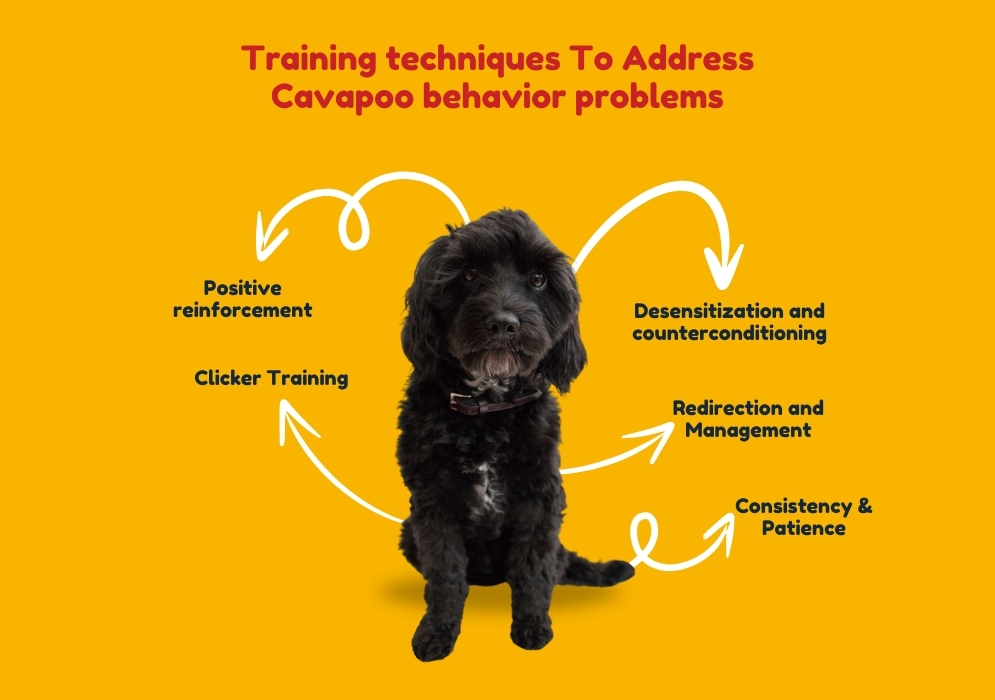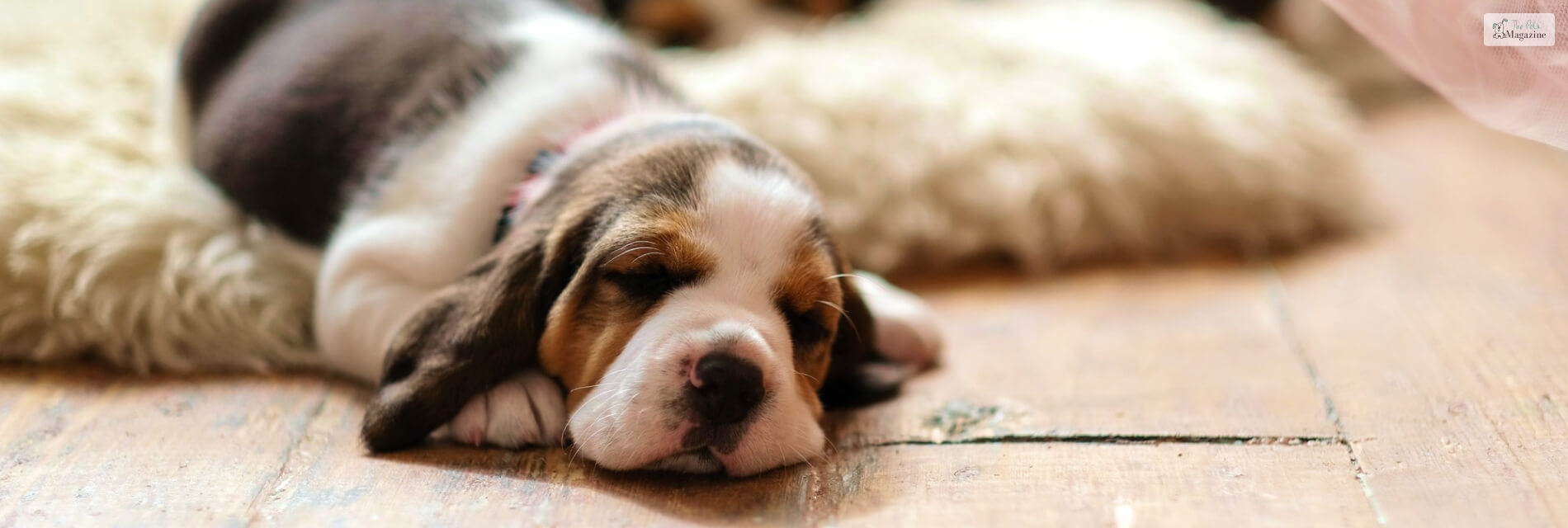Managing Cavapoo Behavior Problems: Your Guide to a Well-Behaved Fur Buddy


Cavapoos, like all dogs, are individuals with unique personalities and quirks. Various factors, including genetics, environment, socialization, and training can influence their behavior. Some common triggers for unwanted behavior include lack of exercise, boredom, anxiety, fear, or even underlying medical conditions.
By identifying the underlying causes, you can better address and modify these behaviors. This will ensure that you have a happier and more well-adjusted companion. It’s important to remember that behavior problems are not a reflection of your love or commitment as a pet parent.
With patience, consistency, and the right approach, you can overcome behavioral challenges easily and strengthen the bond with your Cavapoo. This guide will provide you with the tools and strategies you need to manage Cavapoo behavior problems and cultivate a well-behaved fur buddy.
Common Cavapoo Behavior Problems and Their Causes

Cavapoos, like all dogs, can exhibit a range of behavior problems that may seem puzzling or frustrating. Understanding the root causes of these issues is crucial in addressing them effectively.
Here are some potential causes behind your Cavapoo behavior problems:
Excessive Barking
Cavapoos are known for their vocal nature, but excessive barking can become a nuisance. This behavior may stem from boredom, attention-seeking, territorial instincts, or even separation anxiety.
Destructive Chewing
Chewing is a natural behavior for dogs, but it can become problematic when your Cavapoo starts destroying household items. This could be due to a lack of mental stimulation, teething (in puppies), or separation anxiety.
Jumping and Nipping
While playful jumping and nipping may seem harmless, it can quickly become a problem if left unchecked. This behavior may be a result of inadequate training, excitement, or a lack of socialization.
Potty Training Issues
Accidents in the house can be frustrating, but various factors, including medical issues, stress, or inconsistent training, may cause them.
Separation anxiety
Cavapoos are highly social and can develop separation anxiety when left alone for extended periods. This can manifest in destructive behavior, excessive barking, or even house soiling.
Fear and Aggression
While Cavapoos are generally friendly, they may exhibit fear or aggression towards strangers, other animals, or in certain situations. This could be due to a lack of socialization, traumatic experiences, or even genetic predisposition.
You need to know the underlying causes of these behavior problems because it will help you address them effectively. Also, by identifying the triggers in your dog, you can tailor your approach and implement appropriate strategies to modify and manage these behaviors.
Tips for Preventing Cavapoo Behavior Problems

Prevention is always better than cure, and this saying holds true regarding managing behavior problems in dogs. By taking proactive measures, you can reduce the likelihood of unwanted behaviors from developing or further escalating.
Here are some tips to help you prevent Cavapoo behavior problems:
Proper Socialization
Socializing your Cavapoo from an early age is crucial for their development. Expose them to a variety of people, animals, and environments in a positive and controlled manner. This will help them become well-adjusted and confident in various situations.
Mental and Physical Exercise
Cavapoos are intelligent and energetic dogs that require both mental and physical stimulation. Provide them with interactive toys, puzzle feeders, and regular exercise to prevent boredom and destructive behaviors.
Consistent Training
You should start establishing clear rules and boundaries from the very start. Along with that, keep following them through positive reinforcement training methods. This will help your Cavapoo understand what is expected of them and promote good behavior.
Routine and Structure
Cavapoos thrive on routine and predictability. Establish a consistent schedule for feeding, exercise, playtime, and potty breaks. This will help them feel secure and reduce anxiety-related behaviors.
Proper Supervision
Supervise your Cavapoo, especially during the early stages of training and when introducing new environments or situations. This will allow you to intervene and redirect any unwanted behaviors before they become ingrained habits.
Environmental Management
Manage your Cavapoo’s environment by providing appropriate chew toys, removing temptations for destructive behavior, and ensuring they have a comfortable and safe space to rest and play.
By applying these preventive measures, you can create a loving and positive environment for your Cavapoo. This will reduce the likelihood of behavior problems and foster a strong bond with your furry companion.
Training Techniques to Address Cavapoo Behavior Problems

If and when behavior problems do arise, they need to be addressed through effective training methods. This should also be done as soon as you notice any slight behavioral problems and not wait till things get out of hand.
Here are some proven training techniques to help you tackle Cavapoo behavior problems:
Positive Reinforcement
Positive reinforcement is a powerful training method wherein desired behaviors are rewarded with treats, praise, or other positive reinforcers. This approach encourages your Cavapoo to repeat the desired behavior while avoiding punishment or aversive methods.
Clicker Training
Clicker training is a form of positive reinforcement that uses a distinct sound (the click) to mark the desired behavior. This clear communication helps your Cavapoo understand exactly what behavior is being rewarded, making it an effective training tool.
Desensitization and Counterconditioning
For behaviors rooted in fear or anxiety, desensitization, and counterconditioning can be helpful. This involves gradually exposing your Cavapoo to the trigger in a controlled and positive environment while associating it with something they enjoy, like treats or praise.
Redirection and Management
In some cases, it may be necessary to redirect your Cavapoo’s attention or manage the environment to prevent unwanted behaviors. For example, if your Cavapoo is barking excessively, you can divert their attention with a toy or treat or remove any potential triggers from the environment.
Consistency and Patience
Consistency and patience are key when addressing behavior problems. Stick to the same training methods and routines, and be patient as your Cavapoo learns and adapts. Behavior modification takes time and effort, but the rewards of a well-behaved companion are worth it.
Remember, these are just general guidelines, so you must adjust your approach according to your dog’s temperament, personality, and unique behavioral problems.
Managing Cavapoo Behavior Problems in Different Environments
Cavapoos are intelligent and adaptable companions, but their behavior can be influenced by different environments. Whether it’s a new setting, a crowded public space, or a visit to the veterinarian, managing your Cavapoo’s behavior in various situations is essential for their well-being and the safety of those around them.
Here are some strategies to help you manage Cavapoo behavior problems in different environments:
Socialization and Exposure
Proper socialization from an early age can help your Cavapoo become more comfortable and confident in different environments. Gradually expose them to new sights, sounds, and experiences in a positive and controlled manner.
Consistent Training
Reinforce basic obedience commands and cues in various settings. This will help your Cavapoo understand that the rules and expectations remain the same regardless of the environment.
Environmental Management
Identify potential triggers or distractions in different environments and take steps to manage or minimize them. For example, using a front-attaching harness or a head halter can help you maintain better control in crowded areas.
Positive Reinforcement
Carry high-value treats or interactive toys with you and reward your Cavapoo for calm and appropriate behavior in new or challenging environments. This will reinforce the desired behavior and create positive associations.
Calming Aids
In some cases, you may consider using calming aids, such as pheromone diffusers or anxiety wraps, to help your Cavapoo remain relaxed and focused in stressful situations.
Gradual Exposure
If your Cavapoo exhibits fear or anxiety in a particular environment, gradually expose them to it in small, controlled increments while providing positive reinforcement and creating positive associations.
By combining positive reinforcement training, environmental management, and gradual exposure, you can help your Cavapoo feel more confident and comfortable in various settings, ensuring a more enjoyable and stress-free experience for both of you.
However, if your Cavapoo’s behavior problems continue to occur even after applying the above-mentioned techniques, then the onsider should seek the guidance of a certified animal behaviorist or a professional dog trainer. They can provide personalized strategies and support.
Seeking Professional Help for Severe Cavapoo Behavior Problems
While many Cavapoo behavior problems can be addressed through consistent training, patience, and positive reinforcement, there may be instances where professional help is necessary.
Severe or persistent behavior issues can be challenging to manage on your own, and seeking guidance from qualified professionals can provide valuable insights and effective strategies. Here are some situations where seeking professional help may be beneficial:
Aggression or Fear-related Issues
If your Cavapoo exhibits severe aggression or fear-related behaviors, such as biting, lunging, or excessive growling, it’s important to seek professional assistance. These behaviors can be rooted in complex underlying issues and may require specialized interventions.
Separation Anxiety
Severe cases of separation anxiety can be distressing for both you and your Cavapoo. If your furry friend exhibits destructive behavior, excessive vocalization, or self-harm when left alone, despite your efforts to address the issue, professional guidance may be necessary.
Compulsive or Repetitive Behaviors
Behaviors like excessive licking, pacing, or tail-chasing can be signs of underlying compulsive disorders. These issues can be challenging to address without the expertise of a qualified animal behaviorist or veterinary behaviorist.
Lack of Progress With Training
If you’ve consistently applied positive reinforcement training techniques but see little to no progress in addressing your Cavapoo’s behavior problems, seeking professional help can provide fresh insights and tailored strategies.
Multiple or Complex Behavior Issues
When dealing with multiple or interrelated behavior problems, it can be beneficial to seek the guidance of a professional who can assess the situation holistically and develop a comprehensive treatment plan.
Several types of professionals can assist with severe Cavapoo behavior problems:
- Certified Animal Behaviorists: These professionals have extensive education and experience in animal behavior and can provide in-depth assessments, behavior modification plans, and ongoing support.
- Veterinary Behaviorists: These are veterinarians who have specialized training in animal behavior and can address behavior issues from both a medical and behavioral perspective.
- Professional Dog Trainers: Experienced trainers who specialize in behavior modification can offer personalized training programs and guidance tailored to your Cavapoo’s specific needs.
When seeking professional help, it’s important to choose a qualified and reputable professional. Before hiring their services, make sure that they use positive reinforcement-based methods. They should also be able to provide a comprehensive assessment, develop a customized treatment plan, and offer ongoing support and guidance throughout the process.
Seeking professional help may involve additional costs. But it can be a worthwhile investment in ensuring the well-being of your Cavapoo. It will also foster a strong, positive relationship. With the right guidance and commitment, even severe behavior problems can be effectively addressed. This will allow you and your furry companion to enjoy a harmonious and fulfilling life together.









Leave A Comment